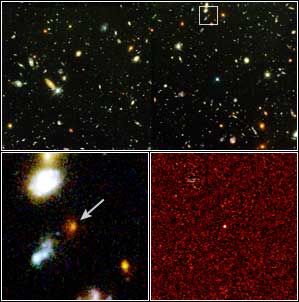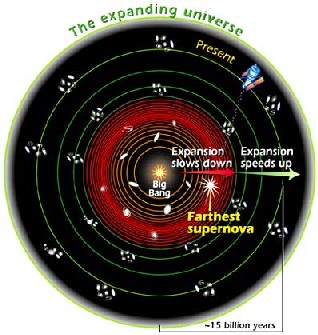...... And what is dark energy?
The term Quintessence was used more
than 2000 years ago by the Greeks to indicate a hypothetical fifth "element" of nature,
after earth, air, fire and water.
Today this term has been adopted as a synonym of
dark energy![]() .
But what is dark energy?
.
But what is dark energy?
In 1998 two groups of astronomers published the results of their studies into possible anomalies in the expansion of the Universe.
They looked at very distant galaxies and studied in particular
Supernovae
![]() type 1a(SN1a), which are very bright and which all have the same luminosity for a certain period of time.
For this reason they can be considered as standard sources, as "standard candles".
From the luminosity observed, scientists can work out their distance, because the luminosity observed decreases
with the square of the distance from Earth.
type 1a(SN1a), which are very bright and which all have the same luminosity for a certain period of time.
For this reason they can be considered as standard sources, as "standard candles".
From the luminosity observed, scientists can work out their distance, because the luminosity observed decreases
with the square of the distance from Earth.
This is a difficult thing to study for two reasons: firstly, Supernovae are very rare, and secondly,
the measurements are difficult and require the use of a variety of extremely powerful telescopes.
Furthermore, the speed at which these distant galaxies move away from us can be measured by looking at the
displacement towards the red of the light that we receive.
 |
Fig. 1:
Images
relating to the sighting of one of the most distant supernovae ever seen, the supernova 1997ff, using the
Hubble Space Telescope (Credit: NASA, Adam Riess (Space Telescope Science Institute, Baltimore, MD)) |
The results of these studies are incredible. The supernovae are not as bright as we would expect from an expansion of the Universe slowed down due to the effect of gravity. The supernovae are more distant than we thought: everything happens as though the expansion of the Universe were accelerating!
In the next few years new, more systematic measurements will be made using even more powerful telescopes. We will then see if today’s results are confirmed
|
Fig. 2: The
drawing
shows the expansion of the Universe from the moment of the
Big Bang (Credit: Ann Feild (STScI)) |
What can this
repulsive force be which is accelerating the Universe and which, with its density of energy,
contributes to the total density of the Universe? It is worth remembering that in the theory of
Special Relativity![]() matter and energy are equivalent: mass and energy are in fact linked by the relation E=mc2.
matter and energy are equivalent: mass and energy are in fact linked by the relation E=mc2.
Some physicists believe that this repulsive effect can be traced back to the energy of
vacuum.
In fact, in modern physics, an empty space does not correspond to the "philosophical void".
In the physical vacuum, thanks to Heisenberg’s
principle of indetermination
![]() pairs of particles-antiparticles appear and disappear – they are virtual, but they can have tangible effects.
It is thanks to them that the vacuum can have an invisible, "dark"
energy density, different from zero,
and can have a repulsive gravitational effect. In other words, the vacuum is not something inert; its effects seem
to dominate the behaviour of the Universe, and our understanding is limited by our ignorance of the subject.
pairs of particles-antiparticles appear and disappear – they are virtual, but they can have tangible effects.
It is thanks to them that the vacuum can have an invisible, "dark"
energy density, different from zero,
and can have a repulsive gravitational effect. In other words, the vacuum is not something inert; its effects seem
to dominate the behaviour of the Universe, and our understanding is limited by our ignorance of the subject.
In 1916 Einstein introduced a constant (the cosmologic constant
![]() ) into the equations of
General Relativity
) into the equations of
General Relativity![]() )
in order to avoid an expanding Universe, but rather try to have a static Universe.
More general solutions (without a cosmologic constant) were obtained by the Russian Alexander Friedmann in 1922 and,
then by the Belgian Georges Lemaître in 1927. Today, a positive value of the cosmologic constant can help us to recognise
the accelerated expansion of the Universe.
)
in order to avoid an expanding Universe, but rather try to have a static Universe.
More general solutions (without a cosmologic constant) were obtained by the Russian Alexander Friedmann in 1922 and,
then by the Belgian Georges Lemaître in 1927. Today, a positive value of the cosmologic constant can help us to recognise
the accelerated expansion of the Universe.
It has been estimated that dark
energy dominates the energetic content of the Universe contributing a long 65%.
The remaining 35% is due to mass. These measurements seem to find confirmation from the measurements of
the microwaves
background cosmic radiation
![]()
